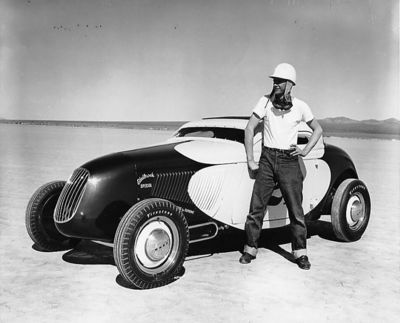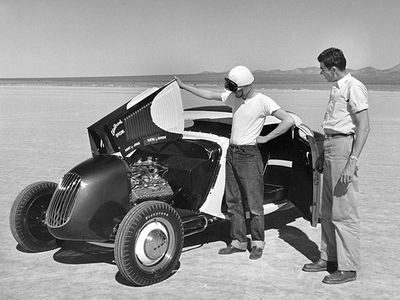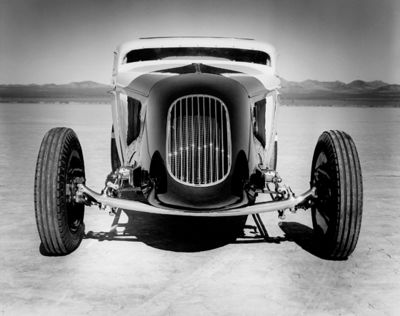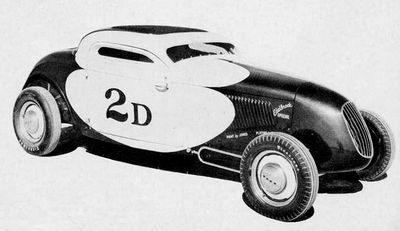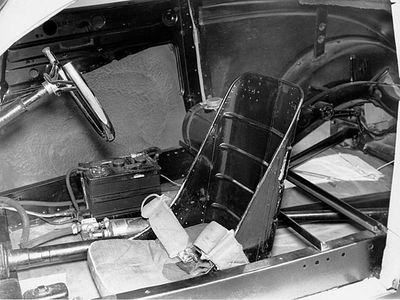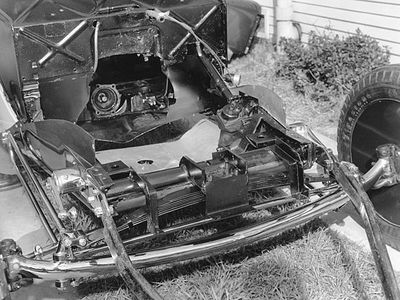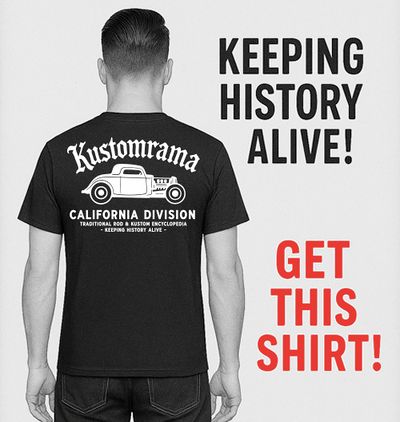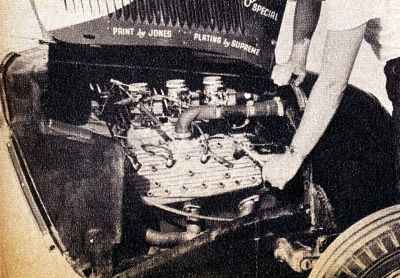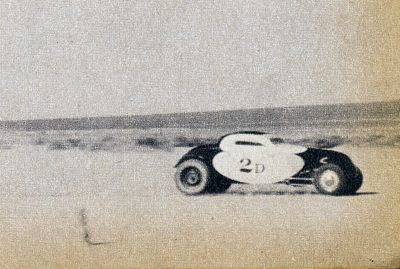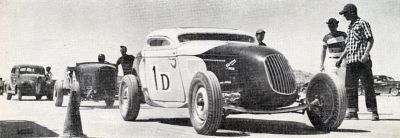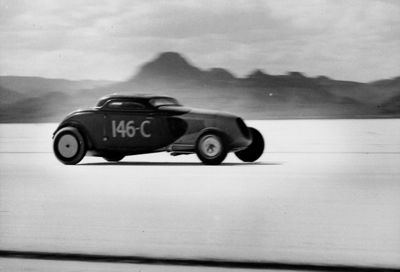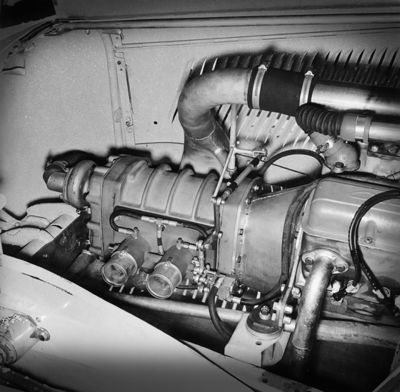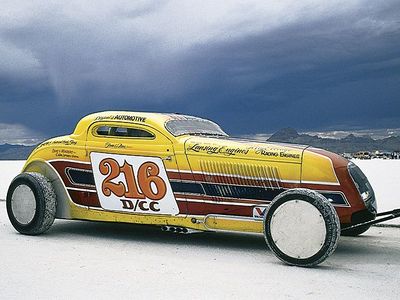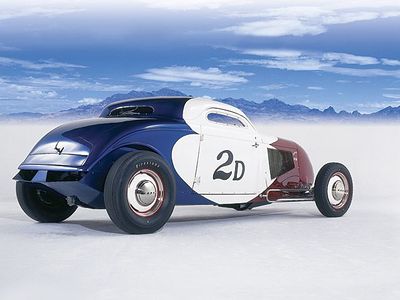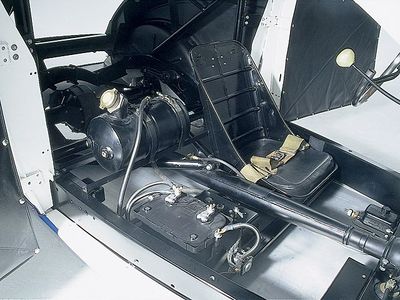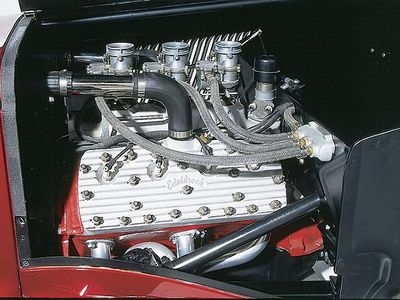Pierson Brothers' Coupe





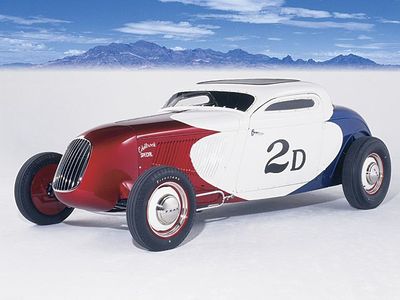

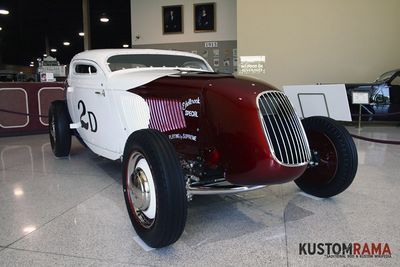
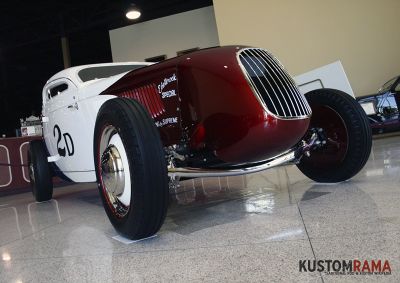

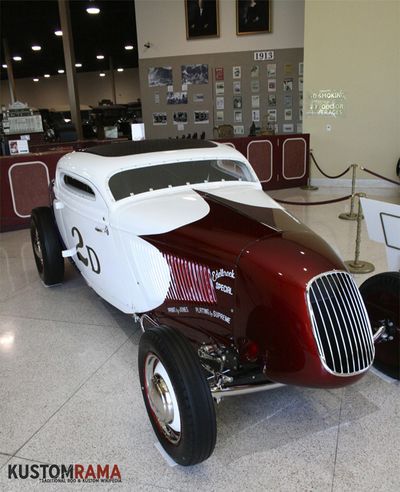



1934 Ford 3-Window Coupe originally owned by Bob and Dick Pierson of Inglewood, California. With a 142 mph Rusetta Timing Association record, the coupe was for a while known as the fastest closed car in America! It was known as the coupe that beat the roadsters. "We didn't think coupes were real hot rods," says Alex Xydias, an SCTA Board Member at the time. "We were very conservative guys and these cars didn't fit our pattern. At first, we didn't even believe the numbers. Of course, when Lou Baney and the Pierson brothers started going fast, we had to give in. I actually recruited Bob to run under the Glendale Sidewinders banner so we could win the points championship one year."[7]
Dick Pierson bought the coupe to use as his school and work transportation. The coupe was a pile of junk, so he only had to pay $25 for it. Dick and his brother Bob took the car to Bobby Meeks where they tore it apart trying to fix the parts that were falling off. Their parents told them not to turn the car into a hot rod, but they didn't care. Meeks worked for Vic Edelbrock, and one of his jobs at Edelbrock was to find boys that could be successful racers. Meeks recruited potential candidates, and helped them with the latest equipment. It was Meeks who decided on the excessive roof chop on the coupe. The rules said that the windshield had to be seven inches high, but they didn't specify the angle, so Meeks laid the posts back about 50 degrees before he raised them up a bit.[7] With these modifications, the Pierson Brothers' 34 was the first known coupe with slanted windshield posts.
After Bobby's dog knocked over a welding gas bottle, breaking the top off and sending it down the street like a rocket, Bobby's wife told Bob and Dick to take the car someplace else. They moved their project to T&T Engineering in Gardena, California where Tommy Backe did the welding and fabrication. In between, the coupe went to Vic Edelbrock's shop for engine work by Meeks. Bob Pierson worked at Douglas Aircraft, and learned the rudiments of aerodynamics there. The body was streamlined by chopping the top 9 inches, channeling it 3 inches, slanting the windshield posts, removing the fenders and by installing a race car nose crafted by Harry Jones. The nose was fit with a Kurtis midget front nose grille.[1] The stock gas tank was axed and a small racing tank was located alongside the driver, right next to the battery. The frame was a rebuilt 1934 Ford frame with X-crossmembers and front crossmember removed. The frame ends were cut off in front and a rigid tubing member was installed to support front spring-mounting. The tube front axle came from a 1938 Ford 60 pickup truck, and it was fit with special brackets for attaching chrome-moly adjustable radius rods. 1939 Ford cross steering was used for precise steering. A Halibrand alloy quick-change centersection supported by a modified Model A crossmember and buggy spring permitted a choice of high-speed gears. The first records were set with a 2.94 rearend ratio. Front tires were ribbed 5.00 x 16 Firestones and 7.00 x 16's were used in back on stock Ford steel rims, still wearing 1948 Ford beauty rings and hubcaps.[7] The body was gut for all except bare essentials in order to reduce overall weight to a minimum. Cold steel served as upholstery. Bucket seat, safety belts and a fire extinguisher were part of the car's equipment. The top of the steering wheel was cut off so the driver's already limited vision was further impaired. A flat panel held a row of curved glass Stewart Warner instruments. Windshield and windows were plexiglas.[7]
Bob wanted to run the coupe at the first Bonneville Nationals in 1949, but Vic Edelbrock said no. When Bob complained, Vic told him not to come back to work if he went to Bonneville. Not wanting to loose his job, Bob and Dick took the coupe to El Mirage instead where they broke records at Rusetta events. Vic and Bobby Meeks helped the brothers and supported the car. When the coupe first hit the the track it was primered gray. It would later be painted red, white and blue by Harry Jones. Finding the correct colors for the white and blue paint was simple, the red one was harder, and Bob went through dozens of samples before he found the correct one.[1]
When Pierson started to run the coupe hard, it turned out to be too flexible and it didn't want to handle. Vic Edelbrock boxed and welded the frame for the brothers. He also designed and installed a complete roll cage. After these improvements the coupe ran as straight as an arrow. [1]
When the coupe was featured in Hot Rod Magazine April 1950, it was powered by a 1946 Mercury, model 59A, that had been bored and stroked .125 inches, giving it a total displacement of 267.15 cubic inches. The engine was equipped with Edelbrock heads, Edelbrock pistons and an Edelbrock manifold with three Stromberg 48 carburetors that had been converted for use with alcohol fuel. The camshaft was a Winfield grind and the ignition was from Kong. The engine was ported, relieved and fully balanced as well.[2] Cooling was provided by a water storage tank connected to the radiator, while Belond W headers controlled the exhaust.[8]
At the Rusetta Timing Association meet held in July of 1950 the coupe achieved a one-way speed of 153.06 mph, good enough for first-place honors in its class. It also set a new class record with an average speed of 145.64 mph.[8] Later the same year, Bob and Dick drove their coupe at the 2nd annual Bonneville Nationals. At the meet, Bill Likes turned 139.75 mph in the "B" roadster class, while the Pierson Brothers hit 150.00 mph with their coupe. During the meet, Pierson and Likes switched engines. After the engine-switch, Pierson's engine in the roadster turned 141.06 and Likes' "B" engine in the coupe turned a speed of 147.78 mph.[9] During the Nationals, the coupe was clocked at an average speed of 142.9 mph. The speeds at the July Rusetta meet were slightly better than its mark at Bonneville, but the timing equipment used for the Bonneville Nationals were presumed to have been more accurate.[8]
At the opening meet of the 1951 Rusetta speed trials season held at El Mirage April 21-22, 1951 the Pierson Bros. coupe turned 141.73 mph taking first place in the "D Class". The same year, SCTA opened up for coupes at their dry lakes speed trials as well. Pat O'Brien drove the coupe at that meet to a new class record of 151.26 mph. After breaking records with the coupe for two years, the Piersons sold the car to Dawson Hadley and Jim Evans in 1951.[1][3] Hadley and Evans painted it red and yellow before they entered it at the 3rd annual Bonneville Nationals. At Bonneville they competed in both the B and C class. The C Modified Coupe division had a total of 18 entries that year.[4] Evans eventually bought Hadley out, and ran it himself for about a year. In 1953, Evans achieved 165.23 mph with the coupe.[7] Hadley sold the coupe to George Bentley of Sadd, Teague & Bentley.[10]
Bentley sold the coupe to Tom Cobbs who continued to run it at Bonneville. On the salt, Tom set the record in C/CC at 187.987 in 1956 running a blown Chevrolet engine. Cobbs' best one-way time was 196+ mph. In 1958 Tom Cobbs sold the coupe to Bob Joehnck. Bob installed a Chrysler engine and planned to take it to Bonneville as well. After attending the Bakersfield National 1/4 mile he scrapped the idea after experiencing handling problems. He sold the coupe to one of his employees. The next owner found it parked on the street in Santa Barbara and bought it after making some inquiries. He took it to Redding, California where it was stored in a barn for about fifteen years. Dick Schell of Central Valley bought the coupe from the son of the Redding-owner. The owner was not aware of the sale at the time. Schell attempted to prepare the coupe for Bonneville. He sandblasted the car to remove several coats of paint. Unfortunately the sand-blasting damaged some of the aluminum panels. Schell was discouraged with the project, and sold it to Tom Bryant in June of 1980. Bryant bought the car without an engine or transmission. The coupe was in a decent condition and it still had the original closed driveline and a mediocre roll cage. It was painted in red primer and the original firewall had been removed to allow a 25% engine setback. The grille opening had been covered with a piece of aluminum and it still had the original type Ford shock absorbers, Halibrand Quick Change rear axle and knock-off type Halibrand Magnesium rear wheels and spindle mount Halibrand Magnesium front wheels. The steering box was a Ross unit, which steered a 1937 Ford "60" tube front axle and the driver was seated on the original left side position. The cooling for the engine was provided by an aluminum, twenty gallon water tank mounted in the rear of the car.[11]
The Bonneville Speedweek was only about 2 months away when Bryant bought the coupe. Tom equipped the coupe with a better roll cage and put in an order for parts needed to convert the coupe to an open driveline. A 302 cu. in. Chevrolet engine and an aluminum Powerglide transmission were installed. After a few changes were made and safety equipment such as a fire-extinguisher system, five point seat belts, new lexan windshield and window coverings and necessary gauges were installed, Bryant got the coupe ready for the 1980 Bonneville Speedweek. Unable to come up with a rear drive shaft yoke before the Speedweek, he manufactured one himself. After a couple of runs that yielded times in the mid-170's, the yoke snapped and Bryant was unable to make any more runs. Not aware of its story yet, Bryant found out during the week that his coupe was the old Pierson Brothers coupe.[11]
Tom Bryant made over 100 passes on the salt before retiring the car in 1991. Tom set more records than anyone else with the coupe and he holds eight world records at Bonneville and El Mirage with it. The fastest records which are 221.898 mph average speed for 2 miles, 224.679 mph for the fastest mile and 227.330 for terminal velocity. After retiring the old racer, Tom sold it to Bruce Meyer of Beverly Hills, California in January of 1992. Bruce commissioned Pete Chapouris and his crew at So-Cal Speedshop to restore the coupe to its 1950 configuration. When Chapouris got the car, most of the sheetmetal was intact, but over the years extensive frame bracing had been added. Chapouris peeled away the layers until it looked exactly like it did in the Rex Burnett cutaway drawing and on Tom Medley's old photos. Chapouris saved as much of the original steel as he could and metal master Steve Davis massaged the old panels back into shape. During the restoration, traces of the original paint were found underneath several layers of newer color coats. With traces of the original paint saved, the original candy red and blue paint could be duplicated. The front A-pillars were shot, so they had to be replaced during the restoration. Bob Pierson, Dick Pierson and Bobby Meeks helped oversee the restorations. Bobby did also build a new Flathead engine for the coupe.[7]
The restored version of the coupe made its debut in November of 1992. Since then it has made countless public appearances, and it has been on display at various museums such as the Petersen Automotive Museum and the Blackhawk Museum. Meyer is not afraid to use the old race car, and he has raced the coupe up the hill at the Goodwood Festival of Speed in England several times. The old Pierson Brothers' coupe was the first car inducted into the Dry Lakes Hall of Fame,[7] and in 2001 it was amongst the first hot rods to be displayed at the prestigious Pebble Beach Concours d'Elegance.
Magazine Features
Hot Rod Magazine April 1950
Hot Rod Magazine October 1950
Hot Rod Magazine October 1950
Mechanix Illustrated January 1951
Hot Rod Magazine June 1951
Hot Rod Magazine July 1951
Hot Rod Magazine November 1951
Fawcett Book 156 How to Build Hot Rods
Trend Book 110 Hot Rod 1954 Annual
Street Rodder September 2009
The Rodder's Journal 47
Hot Rod DeLuxe 2
References
- ↑ 1.0 1.1 1.2 1.3 1.4 Edelbrock: Made in U.S.A
- ↑ 2.0 2.1 2.2 2.3 2.4 2.5 Trend Book 102 Hot Rods
- ↑ 3.0 3.1 3.2 Hot Rod Magazine July 1951
- ↑ 4.0 4.1 Hot Rod Magazine November 1951
- ↑ Garage Magazine
- ↑ 6.0 6.1 6.2 6.3 6.4 6.5 6.6 Street Rodder - The Pierson Brothers Coupe
- ↑ 7.0 7.1 7.2 7.3 7.4 7.5 7.6 Street Rodder September 2009
- ↑ 8.0 8.1 8.2 Fawcett Book 156 How to Build Hot Rods
- ↑ Hot Rod Magazine October 1950
- ↑ www.dochemp.com
- ↑ 11.0 11.1 Bryant Family Auto
Sources
Hot Rod Magazine April 1950
http://www.bryantauto.com/
http://www.petersen.org/
Did you enjoy this article?
Kustomrama is an encyclopedia dedicated to preserve, share and protect traditional hot rod and custom car history from all over the world.
- Help us keep history alive. For as little as 2.99 USD a month you can become a monthly supporter. Click here to learn more.
- Subscribe to our free newsletter and receive regular updates and stories from Kustomrama.
- Do you know someone who would enjoy this article? Click here to forward it.
Can you help us make this article better?
Please get in touch with us at mail@kustomrama.com if you have additional information or photos to share about Pierson Brothers' Coupe.
This article was made possible by:
SunTec Auto Glass - Auto Glass Services on Vintage and Classic Cars
Finding a replacement windshield, back or side glass can be a difficult task when restoring your vintage or custom classic car. It doesn't have to be though now with auto glass specialist companies like www.suntecautoglass.com. They can source OEM or OEM-equivalent glass for older makes/models; which will ensure a proper fit every time. Check them out for more details!
Do you want to see your company here? Click here for more info about how you can advertise your business on Kustomrama.
